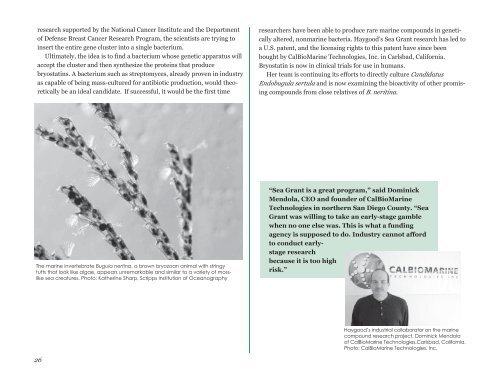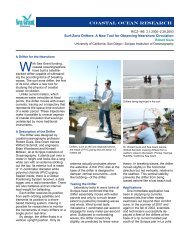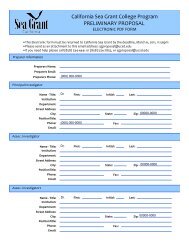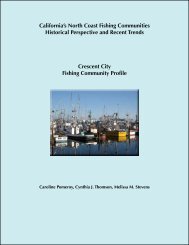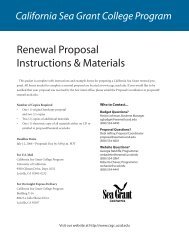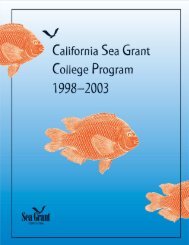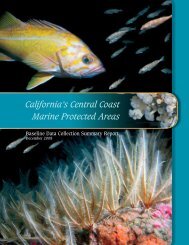2001â2002 - California Sea Grant - UC San Diego
2001â2002 - California Sea Grant - UC San Diego
2001â2002 - California Sea Grant - UC San Diego
You also want an ePaper? Increase the reach of your titles
YUMPU automatically turns print PDFs into web optimized ePapers that Google loves.
esearch supported by the National Cancer Institute and the Department<br />
of Defense Breast Cancer Research Program, the scientists are trying to<br />
insert the entire gene cluster into a single bacterium.<br />
Ultimately, the idea is to find a bacterium whose genetic apparatus will<br />
accept the cluster and then synthesize the proteins that produce<br />
bryostatins. A bacterium such as streptomyces, already proven in industry<br />
as capable of being mass-cultured for antibiotic production, would theoretically<br />
be an ideal candidate. If successful, it would be the first time<br />
researchers have been able to produce rare marine compounds in genetically<br />
altered, nonmarine bacteria. Haygood’s <strong>Sea</strong> <strong>Grant</strong> research has led to<br />
a U.S. patent, and the licensing rights to this patent have since been<br />
bought by CalBioMarine Technologies, Inc. in Carlsbad, <strong>California</strong>.<br />
Bryostatin is now in clinical trials for use in humans.<br />
Her team is continuing its efforts to directly culture Candidatus<br />
Endobugula sertula and is now examining the bioactivity of other promising<br />
compounds from close relatives of B. neritina.<br />
The marine invertebrate Bugula nertina, a brown bryozoan animal with stringy<br />
tufts that look like algae, appears unremarkable and similar to a variety of mosslike<br />
sea creatures. Photo: Katherine Sharp, Scripps Institution of Oceanography<br />
“<strong>Sea</strong> <strong>Grant</strong> is a great program,” said Dominick<br />
Mendola, CEO and founder of CalBioMarine<br />
Technologies in northern <strong>San</strong> <strong>Diego</strong> County. “<strong>Sea</strong><br />
<strong>Grant</strong> was willing to take an early-stage gamble<br />
when no one else was. This is what a funding<br />
agency is supposed to do. Industry cannot afford<br />
to conduct earlystage<br />
research<br />
because it is too high<br />
risk.”<br />
Haygood’s industrial collaborator on the marine<br />
compound research project, Dominick Mendola<br />
of CalBioMarine Technologies,Carlsbad, <strong>California</strong>.<br />
Photo: CalBioMarine Technologies, Inc.<br />
26


